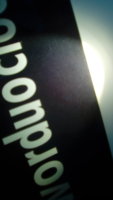BlueToBits
Getting Fingers Dirty
- Joined
- Aug 2, 2017
- Messages
- 18
- Reaction score
- 11
- Points
- 45
- Location
- UK
- Printer Model
- HP 7500 & 1102W, CTC 3D,
Hi.
I need to print black on transparency as opaquely as possible using a HP7500 E910 printer. It's a back-lit sign with clear letters on a black background 400mm x 300mm. I have worked out how to force the printer to print a composite black using CMYK which works best for the self-adhesive transparency film that offers best compromise between my ideal criteria and print opaqueness, but I would still like more black!
It's possible to see on the attached photo that light from a LED desk light through a frost filter bleeds through the black ink. (sorry, I must get a phone with a better camera) .
I have a spare print head and don't mind dedicating it to this job, so I am considering swapping the C, M and Y cartridges for black cartridges in the spare print head and use the original print-head in the printer for other full colour prints. Before committing to this I would like to ask if anyone can foresee any issues, answer any of my questions or offer any advice or suggestions.
I can see a couple of ways to do this.
1. Try to source a black HP cartridge for use in another printer model (?) that is equivalent to the CD972AE, CD973AE and CD973AE possibly needing to swap the chips from used CMY cartridges (I don't mind losing ink level information). I can't find (Google) any except pigment black only available in Thailand (?!).
2. Refilling empty CMY cartridges with black (dye) ink. This is looking favourite.
As I have invested a lot of time in getting to the point I'm at, I don’t want to unnecessarily risk bricking the printer and having to start over again if there's something obvious from the outset that will render this a non-starter.
I have identified a few potential contenders:
1. When reverting to the original CMYK print head for occasional colour printing, could anything within the printer's head cleaning, alignment, ink overflow tank, head 'keeper' or other mechanisms contaminate the 'colour' print head, and if so, will flushing the colour head by printing a page of saturated colours restore this?
2. Will the print head alignment function which uses blue and black boxes still work?
3. Is there a (optical?) sensor that will prevent the wrong colour to be loaded or printed?
4. It took me a day to unblock the spare print head. What’s the best way of keeping the head from drying out when not loaded in the printer?
5. What else have I not considered?
Does anyone have 10 cents worth they can throw in?
Thanks for reading.
I need to print black on transparency as opaquely as possible using a HP7500 E910 printer. It's a back-lit sign with clear letters on a black background 400mm x 300mm. I have worked out how to force the printer to print a composite black using CMYK which works best for the self-adhesive transparency film that offers best compromise between my ideal criteria and print opaqueness, but I would still like more black!
It's possible to see on the attached photo that light from a LED desk light through a frost filter bleeds through the black ink. (sorry, I must get a phone with a better camera) .
I have a spare print head and don't mind dedicating it to this job, so I am considering swapping the C, M and Y cartridges for black cartridges in the spare print head and use the original print-head in the printer for other full colour prints. Before committing to this I would like to ask if anyone can foresee any issues, answer any of my questions or offer any advice or suggestions.
I can see a couple of ways to do this.
1. Try to source a black HP cartridge for use in another printer model (?) that is equivalent to the CD972AE, CD973AE and CD973AE possibly needing to swap the chips from used CMY cartridges (I don't mind losing ink level information). I can't find (Google) any except pigment black only available in Thailand (?!).
2. Refilling empty CMY cartridges with black (dye) ink. This is looking favourite.
As I have invested a lot of time in getting to the point I'm at, I don’t want to unnecessarily risk bricking the printer and having to start over again if there's something obvious from the outset that will render this a non-starter.
I have identified a few potential contenders:
1. When reverting to the original CMYK print head for occasional colour printing, could anything within the printer's head cleaning, alignment, ink overflow tank, head 'keeper' or other mechanisms contaminate the 'colour' print head, and if so, will flushing the colour head by printing a page of saturated colours restore this?
2. Will the print head alignment function which uses blue and black boxes still work?
3. Is there a (optical?) sensor that will prevent the wrong colour to be loaded or printed?
4. It took me a day to unblock the spare print head. What’s the best way of keeping the head from drying out when not loaded in the printer?
5. What else have I not considered?
Does anyone have 10 cents worth they can throw in?
Thanks for reading.


